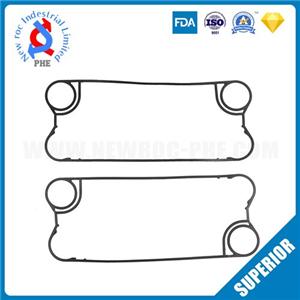The working principle of plate heat exchanger in chlor-alkali
As we all know, chlor-alkali production is a high-energy-consuming industry. In recent years, with the increasing production scale of chlor-alkali plants, the total energy consumption has also increased. Because the energy consumption and investment of heat exchangers account for the high cost of caustic soda, the application of new plate heat exchangers is becoming more and more important in the expansion of chlor-alkali enterprises.
Plate heat exchanger is a kind of heat exchange equipment with compact structure and high performance. Compared with the tube heat exchanger: it occupies only about 20% of the tube heat exchanger. Because of the increased disturbance, the heat transfer is enhanced, and the heat transfer efficiency is increased by 4 to 5 times. It is sensitive in assembly, has low heat loss, does not require an insulation layer, is light in weight, is convenient to disassemble and repair, and is widely used in various industrial production.
1, Operation principle and performance comparison
In the plate heat exchanger, the heat exchanger plates are heat transfer elements, which are hung on the guide rods, and heat exchanger gaskets are attached to the plates. The heat exchange plates are assembled according to the design requirements and then compressed. The fluid flowing in the plate heat exchanger enters the heat exchange plate channel through the corner holes on the heat exchange plate, and the heat exchange between the hot and cold fluids is achieved. Ordinary plate heat exchangers are mainly used for heat exchange occasions without phase change. There are also condensing plate heat exchangers for gas condensation, and welded plate heat exchangers with higher pressure resistance.
2, Application examples of each process in a chlor-alkali plant
In a chlor-alkali plant, in addition to the heating chamber of the evaporator and the concentrated alkali cooler that cannot use the plate heat exchanger due to the presence of crystalline salt, the plate heat exchanger can function well in other processes where the heat exchanger can be used.
(1) Silicon rectification process
Both of the two heat exchangers in the silicon rectification process belong to liquid-liquid heat exchange. Among them, the oil cooler of the transformer can use the plate heat exchanger of aluminum brass plate material and oil-resistant NBR heat exchange gasket; the pure 9 water cooler of the rectifier cabinet can use the heat exchange plate material of 1Cr18Ni9Ti and NBR heat exchange gasket. Plate heat exchanger.
(2) Brine process
The brine preheater is classified into gas-liquid heat exchange. At the same time, due to the presence of electrochemical corrosion of the brine medium, it is necessary to use austenitic stainless steel above 1Cr18Ni9Ti as the raw material for the heat exchange plate, and the heat exchange gasket is a condensing plate heat exchanger with NBR.
(3) Chlorine gas treatment process
In the chlorine treatment process, the titanium tube cooler plate can use TA2 titanium material. Because the chemical corrosion of wet chlorine is heavier, the oxidation-resistant EPDM rubber heat exchange gasket is selected, and there is condensation of chlorine water, so it is necessary to use it. Condensing plate heat exchanger; the same chlorine water cooler can use the plate heat exchanger with the heat exchange plate material being TA2 and the heat exchange gasket being EPDM; the circulating acid of the Nessler pump and the circulating acid heat exchanger plates of each tower It can use Hastelloy C-276 material and FKM heat exchange gasket which is resistant to corrosion by concentrated sulfuric acid and chlorine.
(4) Liquid chlorine process
In the liquid chlorine process, regardless of whether the ammonia refrigeration is used or the Freon refrigeration is used, the liquefaction of the refrigerant can use the plate heat exchanger with the heat exchange plate material of 1Cr18Ni9Ti. Because the compressed gas pressure is higher, this plate heat exchanger It is necessary to use a welded heat exchanger. Although the plates cannot be disassembled and inspected, the service life can reach more than 8 years because of the weak corrosiveness of the medium.
The chlorine liquefier can use a condensing plate heat exchanger whose heat exchange plate material is 1Cr18Ni9Ti, and its heat exchange gasket is the same as the titanium tube cooler and chooses EPDM.




